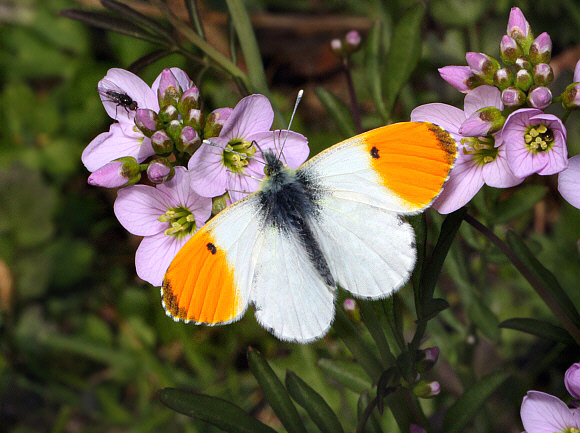 Orange tip Anthocharis cardamines, male, Dunsfold, Surrey – Adrian Hoskins
Orange tip Anthocharis cardamines, male, Dunsfold, Surrey – Adrian Hoskins
Introduction
The Orange tip, like the primrose and the cuckoo, is a true herald of spring. It is one of the very few species that are on the increase in Britain, having spread northwards in recent decades, whilst still remaining widespread and abundant in the south.
| The orange tips on the male’s forewings are believed to be aposematic, acting as a warning to birds that the butterflies contain toxins ( mustard oils ) derived from the larval foodplants, garlic mustard and cuckoo flower. Females lack the orange – they lead much more sedentary and inconspicuous lives so possibly have less need to “advertise” their toxicity. |
There is virtually no variation in the colouring or patterning of Orange tips, but there is undersized specimens are often seen. The smaller butterflies probably result from caterpillars that have fed on cuckoo flower – these plants often have barely enough foliage to sustain them, so it is possible that they literally run out of food and pupate early.
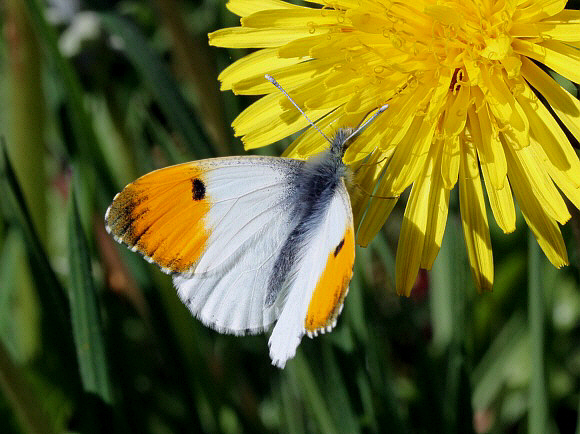 Anthocharis cardamines, male at dandelion, Stansted Forest, Sussex – Adrian Hoskins
Anthocharis cardamines, male at dandelion, Stansted Forest, Sussex – Adrian Hoskins
In Europe female Orange tips can easily be confused with the Dappled Whites Euchloe ausonia and E. simplonia although both of these are more heavily marked with green on the underside, and have more angular forewings.
Elsewhere in the northern hemisphere there are several other Anthocharis species including cethura from California, sara from Alaska and bieti from Tibet and Siberia. Zegris fausti from Turkestan is also similar in appearance but has a strongly curved forewing costa. The 40 African Colotis “Orange tips” have plain undersides, and are only distantly related.
Anthocharis cardamines is found throughout most of Europe, but is absent from much of the Iberian peninsula and from sub-arctic areas of Scandinavia. It’s range extends eastward across temperate Asia to Amurland and Japan.
Habitats
In southern Britain the Orange tip can be encountered in almost any habitat, but is most commonly seen in damp sheltered areas where it’s larval foodplants grow. These include riverbanks, ditches, dykes, hedgerows, damp meadows, fens, railway cuttings, woodland glades and country lanes. The butterflies wander almost randomly across the countryside, unlike in northern England and Scotland where they breed in localised colonies, usually close to river banks. In mainland Europe the species is found in a much wider range of habitats including marshes, moorlands, arid scrub, and on alpine meadows and pastures at altitudes up to 2100m.
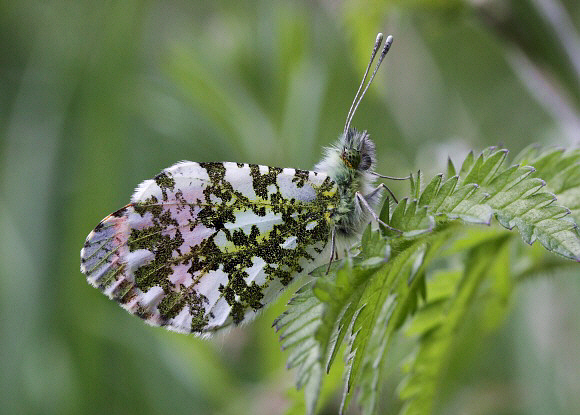 Orange tip Anthocharis cardamines, male, Evington meadow, Leicestershire – Adrian Hoskins
Orange tip Anthocharis cardamines, male, Evington meadow, Leicestershire – Adrian Hoskins
Lifecycle
Orange tips usually begin to emerge in mid April, but can appear as early as the end of March if the spring is exceptionally warm. The peak flight season for both sexes is early May. By the end of May the males have disappeared and just a few females remain. In Europe the flight season is longer, with the butterflies still on the wing in early July at moderate altitudes in the Alps.
Weather conditions during the flight season have a great affect on butterfly abundance the following year. In early seasons a high percentage of eggs are laid on cuckoo flower Cardamine pratensis but in late seasons the majority are laid on garlic mustard Alliaria petiolata. Larval survival is higher on garlic mustard, probably because it produces larger and more profuse seed pods and leaves for the larvae to eat. Hence in a late season tends to result in higher numbers of adults the following year.
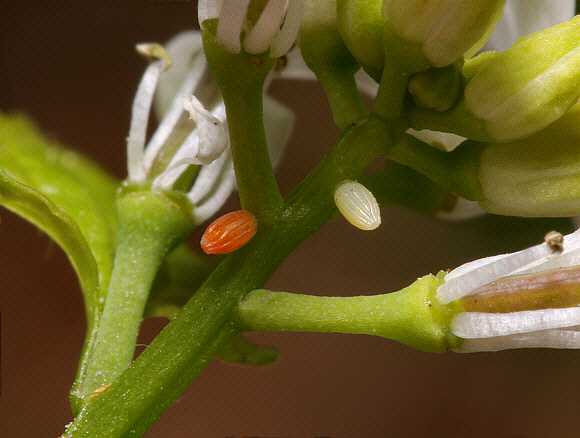
Anthocharis cardamines – the egg on the right is freshly laid, that on the left is about 3 days old.
Although cuckoo flower and garlic mustard are the primary larval foodplants, females occasionally oviposit on charlock, hedge mustard or watercress; but regardless of the plant chosen, the eggs are always laid singly, and always in the same position – on the flower stalks. Sometimes more than one egg can be found per plant, but this is unusual, as the butterflies seem able to detect the presence of eggs that have already been laid. The eggs are skittle-shaped and greenish-white in colour when first laid, but turn to orange after a day or two, and then finally to grey.
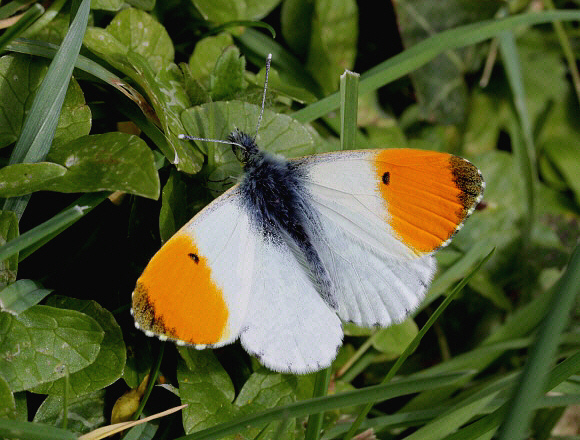
Orange tip Anthocharis cardamines Stansted Forest, Sussex – Adrian Hoskins
The larvae hatch after about a week and feed at first on the flowers of the foodplants. When older they move on to feed on the leaves, flower stalks and seedpods. Fully grown larvae are pale bluish green with a white lateral line, below which the colour changes to dark green. They habitually rest on the upper surface of the seedpods where they are superbly camouflaged. Despite their disguise however many are eaten by spiders and birds. They are also parasitised by the Tachinid fly Phryxe vulgaris, which also attacks the larvae of several other butterflies.
Orange tip larvae are noted for their cannibalistic tendencies. This may have evolved because some of the larval foodplants ( e.g. cuckoo flower ) only produce enough seed pods and foliage to sustain a single larva through to full development.
Caterpillars which have been feeding on cuckoo flower leave the plants when ready to pupate, and attach themselves with a silken girdle to a nearby woody stem. Larvae on garlic mustard however often pupate on the stems of the plant.
The distinctive boomerang-shaped pupa cannot be mistaken for any other species. It occurs in two colour forms – pale green, or brownish. The latter is by far the commoner. In 2009, I made a quick search of a clump of garlic mustard in a Sussex woodland, and found 5 pupae, of which 4 were the normal brownish form, and one of the green form. One pupa was parasitised, another had been nibbled by a small mammal ( probably a pigmy shrew ), and the remainder were healthy. All were attached to the stems of dead garlic mustard plants.
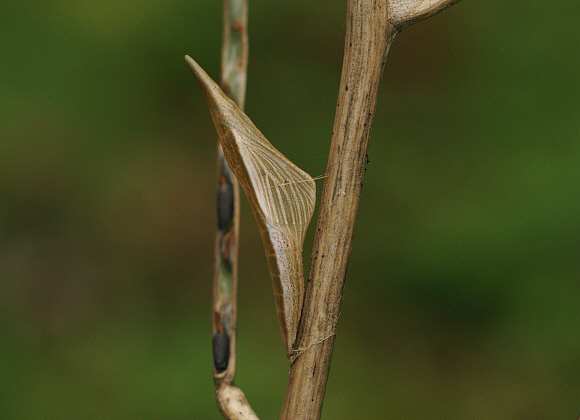 Anthocharis cardamines, pupa ( normal form ) on garlic mustard stem – Adrian Hoskins
Anthocharis cardamines, pupa ( normal form ) on garlic mustard stem – Adrian Hoskins
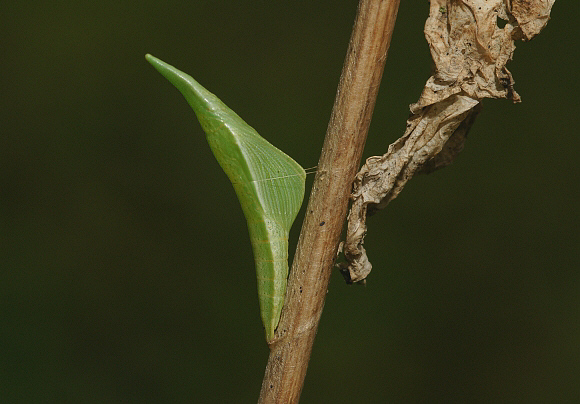
Anthocharis cardamines, pupa ( green form ) on garlic mustard stem – Adrian Hoskins
Adult behaviour
Male Orange tips begin emerging in early April, followed about a week later by the females. As with most butterfly species, female Orange tips must mate within a couple of days of emergence, after which they lose their attraction to the males. The staggered emergence is nature’s way of ensuring that there are plenty of males available when the females emerge.
When seen in flight, female Orange tips can be difficult to distinguish from Green-veined Whites, but when they settle, the beautiful mottled green markings on the underside hindwings make them easy to identify. The green colour is actually an illusion caused by a mottling of black and yellow scales. The markings are an extremely effective camouflage which works against a variety of backgrounds – the butterflies are equally difficult to spot when at rest on bracken fronds, hazel leaves, or nettles; or on the white flowers of garlic mustard or umbellifers.
Orange tips visit a wide variety of wild flowers including bluebell, bugle, wood anemone, blackthorn, primrose, ground ivy, celandine, hawthorn, garlic mustard, early purple orchid, common vetch, dog violet, colt’s foot, dandelion and cuckoo flower.
When nectaring or settling for short periods, they normally keep their wings half open. This has the effect of trapping a tiny pocket of warm air over the thorax, which aids rapid body warming. In hazy weather or late evening sunshine however Orange tips often bask for long periods with the wings fully outspread.
On sunny days males patrol incessantly in search of females. When the sexes meet copulation takes place almost immediately, and without any prenuptial ritual. If a female that has previously mated is intercepted by a male, she signals her disinterest by settling on a leaf, then outspreading her wings and raising her abdomen as illustrated below. This tells the male that she is unreceptive, and makes it physically impossible for him to copulate.
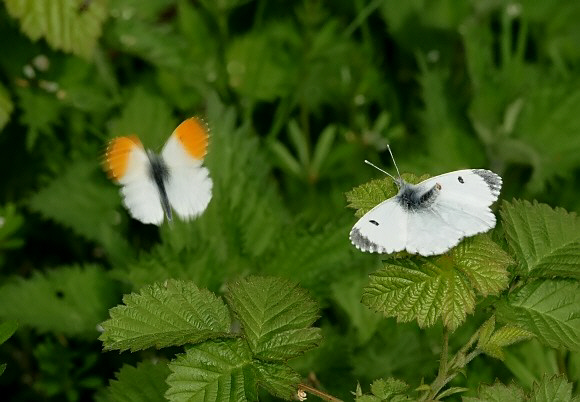
Anthocharis cardamines, female ( right ) raising abdomen as a rejection signal – Adrian Hoskins
Orange tips roost openly, even in wet or windy weather, and can be found at dusk and dawn settled on the flower heads of cuckoo flower, garlic mustard, bluebells or umbellifers, or on hazel or nettle leaves, in sheltered and lightly wooded situations.

Anthocharis cardamines, female at roost on hazel, Stansted Forest, Sussex – Adrian Hoskins
